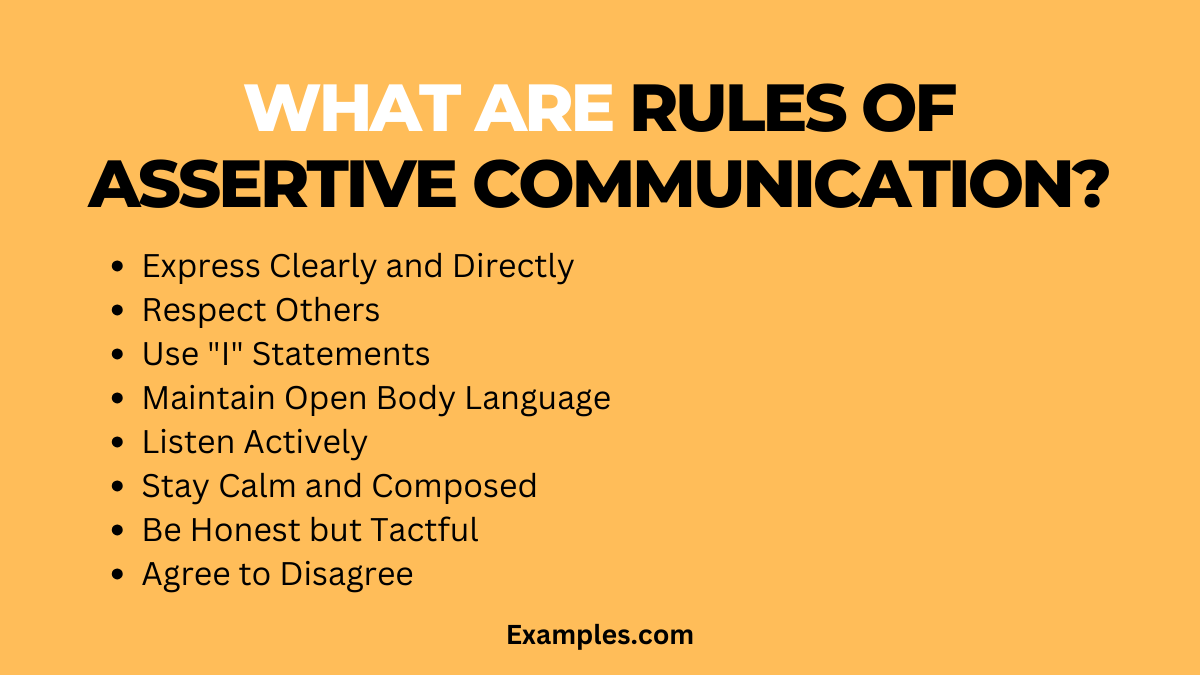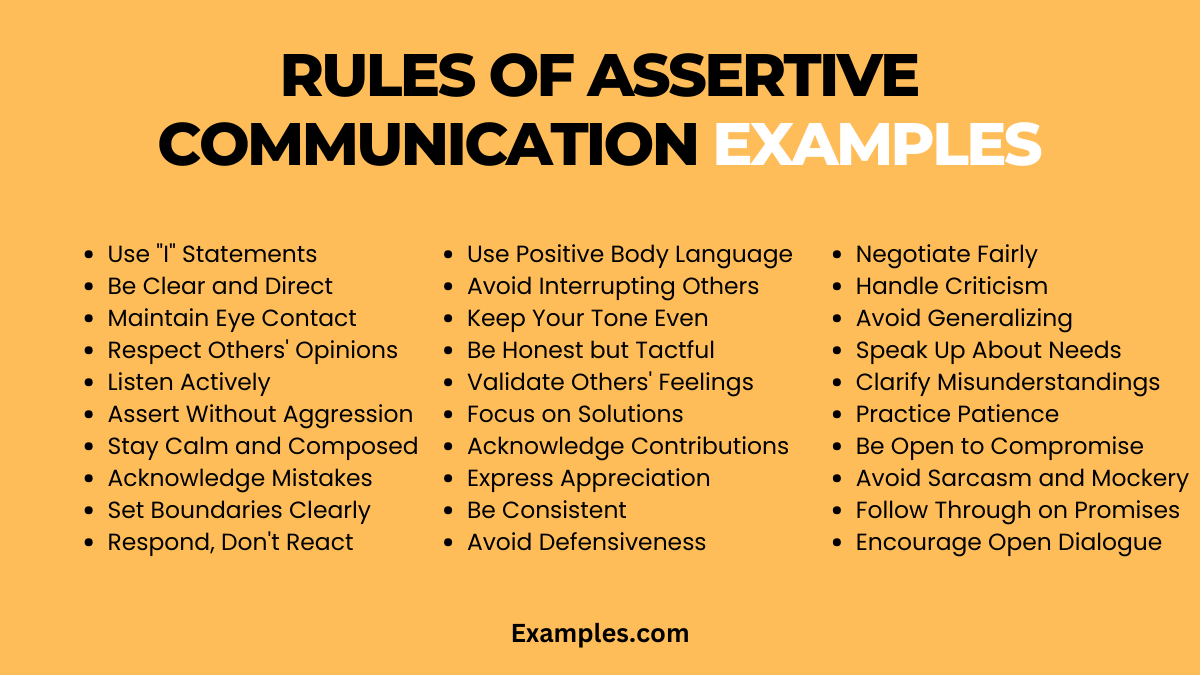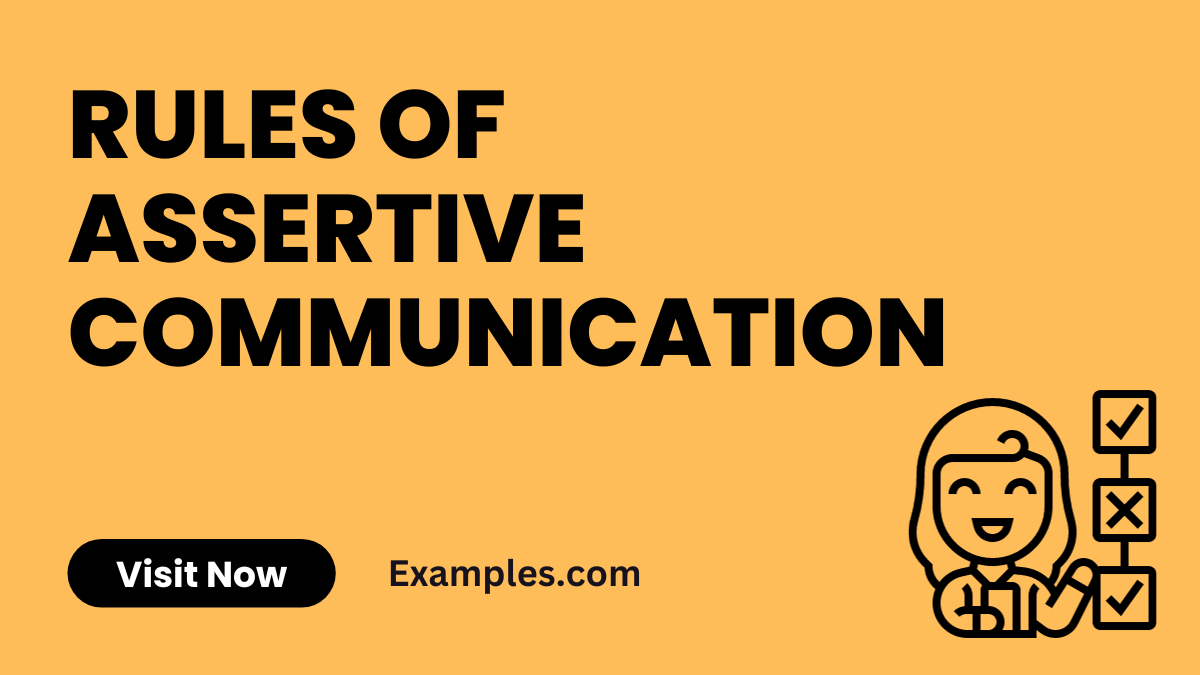29+ Rules of Assertive Communication Examples
Assertive communication is a crucial skill, balancing respect for others with expressing one’s own needs and opinions. This comprehensive guide delves into the essential rules of assertive communication, equipped with real-world communication examples. It outlines strategies for clear, confident, and respectful dialogue. Learn how to express yourself assertively in various contexts, from professional environments to personal relationships. This guide provides valuable insights into maintaining a balance between assertiveness and empathy, ensuring your communication is both effective and considerate.
What are Rules of Assertive Communication?

Assertive communication is governed by a set of fundamental rules that facilitate respectful and effective interactions. Understanding and practicing these rules can significantly enhance your communication skills.
- Express Clearly and Directly: Be transparent about your thoughts, feelings, and needs without ambiguity.
- Respect Others: While expressing yourself, respect the opinions and rights of the listener.
- Use “I” Statements: Frame your messages from your perspective to avoid sounding accusatory.
- Maintain Open Body Language: Non-verbal cues like eye contact and open posture reinforce your verbal message.
- Listen Actively: Show empathy and understanding by actively listening to others’ viewpoints.
- Stay Calm and Composed: Keeping your emotions in check prevents misunderstandings.
- Be Honest but Tactful: Honesty is key, but it should be balanced with tact to avoid offending others.
- Agree to Disagree: Recognize that it’s okay to have differing opinions and that compromise may sometimes be necessary.
By adhering to these rules, your assertive communication can lead to more constructive and positive outcomes in various aspects of life.
30 Rules of Assertive Communication Examples

Understanding the rules of assertive communication is crucial for effective interaction. This guide presents 30 examples, each illustrating a key rule, along with brief explanations on how to apply these rules in real-life scenarios.
- Use “I” Statements: “I feel concerned when meetings start late.”
Express personal feelings without blaming others. - Be Clear and Direct: “I need this report by Tuesday.”
State needs and expectations clearly. - Maintain Eye Contact: “While discussing, I focus on maintaining eye contact.”
Shows confidence and engagement. - Respect Others’ Opinions: “I respect your viewpoint, but I see it differently.”
Acknowledge differing perspectives while asserting your own. - Listen Actively: “I’m listening to understand your perspective.”
Shows empathy and encourages open dialogue. - Assert Without Aggression: “I firmly believe we should reconsider this strategy.”
Be firm yet respectful. - Stay Calm and Composed: “Even in disagreement, I remain calm.”
Keeps the conversation constructive. - Acknowledge Mistakes: “I realize I overlooked that detail.”
Demonstrates honesty and responsibility. - Set Boundaries Clearly: “I’m not available for calls after 6 PM.”
Helps maintain personal limits. - Respond, Don’t React: “I take a moment before responding to difficult comments.”
Avoids impulsive reactions. - Use Positive Body Language: “My posture is open and welcoming.”
Non-verbal cues support your words. - Avoid Interrupting Others: “I wait for my turn to speak.”
Shows respect for the speaker. - Keep Your Tone Even: “I speak in a steady, calm voice.”
Prevents misunderstanding. - Be Honest but Tactful: “I believe there’s room for improvement here.”
Balances truthfulness with sensitivity. - Validate Others’ Feelings: “I understand why you might feel that way.”
Builds empathy and rapport. - Focus on Solutions: “Let’s find a solution that works for both of us.”
Encourages collaboration. - Acknowledge Others’ Contributions: “Your input has been valuable to this project.”
Fosters a positive environment. - Express Appreciation: “I appreciate your hard work on this.”
Reinforces positive behavior. - Be Consistent: “I consistently stand by my decisions.”
Builds trust and reliability. - Avoid Defensiveness: “I accept constructive feedback openly.”
Facilitates growth and learning. - Negotiate Fairly: “Let’s negotiate a solution that benefits us both.”
Promotes fair and effective outcomes. - Handle Criticism Constructively: “I use criticism as an opportunity to improve.”
Turns challenges into growth. - Avoid Generalizing or Exaggerating: “I avoid saying ‘always’ or ‘never’.”
Keeps statements accurate and realistic. - Speak Up About Needs: “I openly communicate my needs.”
Prevents misunderstandings. - Clarify Misunderstandings Promptly: “Let me clarify what I meant.”
Ensures clear communication. - Practice Patience: “I practice patience in conversations.”
Allows time for thoughtful communication. - Be Open to Compromise: “I’m open to finding a middle ground.”
Encourages mutual respect and solutions. - Avoid Sarcasm and Mockery: “I speak sincerely, without sarcasm.”
Maintains respect and understanding. - Follow Through on Promises: “I keep my commitments.”
Demonstrates integrity and reliability. - Encourage Open Dialogue: “I invite open discussion on this matter.”
Creates an inclusive and productive communication environment.
What are the Important Keys of Assertive Communication?
Here is the Important Keys of Assertive Communication:
- Honesty: The cornerstone of assertive communication is honesty. It’s crucial to communicate your thoughts, feelings, and needs truthfully. This transparency helps in building trust and respect in relationships.
- Respect: Assertive communication is grounded in mutual respect. It’s about expressing your views while also valuing others’ opinions and feelings. This respect is pivotal in creating a positive and open communication environment.
- Clarity and Conciseness: Being clear and concise is key in assertive communication. It involves getting your point across effectively without being overly verbose. Clarity ensures that your message is understood, and conciseness keeps the listener engaged.
- Empathy: Empathizing with the listener helps in understanding their perspective. This emotional intelligence is vital in assertive communication as it fosters a deeper connection and understanding between parties.
- Confidence: Confidence in delivery is essential in assertive communication. It conveys the certainty of your message. However, it’s important to balance confidence with humility to avoid coming across as arrogant.
- Non-Verbal Cues: Body language, eye contact, and tone play a significant role in how your message is received. These non-verbal elements of communication should align with your words for effective assertiveness.
- Active Listening: Assertive communication is a two-way street. Active listening involves giving full attention to the speaker, showing interest, and responding appropriately. It validates the other person’s perspective and promotes a healthy dialogue.
- Boundary Setting: Clearly stating your boundaries is a vital aspect of assertive communication. It’s about being honest about what you are and are not comfortable with.
- Responsiveness: Being responsive and open to feedback is crucial. It shows that you are not just expressing your views but are also open to understanding and considering others’ viewpoints.
- Positive Attitude: A positive attitude in assertive communication helps in maintaining a constructive and non-confrontational tone. It’s about focusing on solutions rather than problems.
Following these rules will not only enhance your assertive communication skills but also improve your overall interactions, leading to stronger and more respectful relationships. Remember, assertive communication is about balance – standing up for yourself while respecting others.
What are the Strengths of Assertive Communication Style?
The strengths of an assertive communication style are manifold:
Effective Expression of Needs and Opinions
One of the primary strengths of the assertive communication style is the effective expression of personal needs and opinions. This approach enables individuals to convey their thoughts and feelings clearly and directly, without infringing on the rights of others. By doing so, it promotes honest and open dialogue, essential for healthy interactions both in personal and professional environments.
Building Respect and Understanding
Assertive communication also excels in building respect and understanding between individuals. When people communicate assertively, they express themselves confidently and respectfully, fostering an environment where all parties feel valued and heard.
By integrating these key strengths, assertive communication stands out as a powerful tool for enhancing personal interactions and professional relationships.
Tips for Improving Rules of Assertive Communication
Here is a Tips for Improving Rules of Assertive Communication:
Understanding the Basics
The first step in improving assertive communication involves understanding its core principles. Assertive communication is about expressing your thoughts and feelings confidently and respectfully, without infringing on others’ rights. It’s a balance between being overly aggressive and excessively passive.
Using “I” Statements
One effective technique in assertive communication is the use of “I” statements. This approach involves speaking from your perspective without blaming or criticizing others. For example, instead of saying, “You never listen to me,” try, “I feel unheard when my ideas are not considered.”
Maintaining a Respectful Tone
The tone of your voice plays a significant role in assertive communication. Maintaining a calm and respectful tone, even when discussing contentious issues, is crucial. A respectful tone helps convey your message without triggering a defensive reaction, making it more likely that your words will be received positively.
Displaying Appropriate Body Language
Non-verbal cues, such as body language, greatly impact how your message is perceived. Ensure your body language matches your words. Maintaining eye contact, a relaxed posture, and using appropriate facial expressions can reinforce your assertive message.
Developing Conflict Resolution Skills
Conflict is inevitable, but how you handle it matters. Developing skills in conflict resolution can enhance your assertive communication. Approach conflicts with a solution-oriented mindset, seeking to understand the other party’s viewpoint and finding a mutually beneficial resolution.
In concluding the article on the rules of assertive communication, it’s important to recognize that mastering assertiveness is not just about understanding and applying a set of rules. It’s about developing a communication style that respects both yourself and others, fostering a culture of open and honest dialogue. By adhering to the principles of clear, direct, and respectful communication, you can navigate various interpersonal dynamics effectively. Assertive communication is a tool for building stronger, more positive relationships in both personal and professional spheres.
For further exploration into the importance of assertive communication, the Mayo Clinic offers a comprehensive guide, “Reducing Stress through Assertive Communication,” which discusses the benefits of assertiveness in managing stress and improving relationships. Additionally, Harvard Business Publishing provides insights on “Effective Communications in Challenging Times,” highlighting the significance of assertive communication in complex and demanding professional environments. These resources will deepen your understanding of assertive communication and its practical applications in various contexts.



